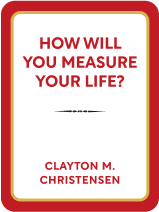

This article is an excerpt from the Shortform book guide to "How Will You Measure Your Life?" by Clayton M. Christensen. Shortform has the world's best summaries and analyses of books you should be reading.
Like this article? Sign up for a free trial here .
What are the key ideas in Clayton Christensen’s How Will You Measure Your Life? How can you use economic theories to find your purpose? How do you measure your life successfully?
Clayton Christensen’s How Will You Measure Your Life is filled with helpful advice for improving your relationships, becoming a better parent, and finding happiness in your career. In particular, Christensen explores economic theories and discusses how you can use them in your life.
Keep reading to find out more about Clayton Christensen’s How Will You Measure Your Life.
Clayton Christensen and How Will You Measure Your Life?
Clayton Christensen’s How Will You Measure Your Life shows how economic theories that help businesses succeed can also help individuals make better life decisions. He presents theories and business case studies that show you pitfalls to avoid, and also how to be happy and successful in your career and personal life.
Typical self-help books on how to succeed and be happy are based mostly on anecdotes and on routines that worked for the authors, but that may or may not work for you. In contrast, Clayton Christensen’s How Will You Measure Your Life focuses on theories. We know theories work: They’re tested, proven, and can be universally applied. A theory is a statement of cause and effect. Economic theories show the impact on a business of doing certain things; they predict what will happen in the future and what steps managers might take. They can do the same for your personal life.
Christensen, author of The Innovator’s Dilemma, uses business theories to explain:
- How to be successful and happy in your career
- How to build relationships with your partner, children, other family members, and close friends that are a lifelong source of happiness
- How to live with integrity
(Shortform note: Read our summary of The Innovator’s Dilemma here.)
Christensen began exploring these questions after finding that many of his former Harvard Business School classmates had struggled in their personal lives and often didn’t enjoy their work, despite significant professional accomplishments. One, Jeffrey Skilling of Enron, ended up in jail.
Clayton Christensen’s How Will You Measure Your Life defines a path to both professional and personal success. It’s intended to help you find fulfillment by understanding what’s most important to you, and ultimately answering the question of how you’ll measure your life.
Applying Theories to Life
Making good decisions in business and life requires understanding what actions cause what outcomes. The business theories explained in this book will help you see cause and effect. Each chapter highlights a business theory and applies it to a personal challenge.
Operating without a theory is like navigating at sea without directional instruments—you’re relying on the currents (outside forces) and chance. However, good theories point you in the direction of good decisions. From there, it’s up to you. Theories tell you how to think about key decisions, not what to think.
Finding Happiness in Your Career
So, how do you measure your life? Christensen offers many ways of doing this, including finding happiness in your career.
A key decision in life is choosing your job or career, but many people choose them for the wrong reasons. They end up unhappy and resigned to the belief that doing what you love isn’t a realistic option. But you don’t have to settle—the key to finding happiness in your career is creating a strategy for where you want to go and how to get there. A successful strategy involves three components:
- Determining priorities based on what truly motivates you
- Balancing plans with opportunities and challenges
- Allocating your resources
Understand What Motivates You
When you feel unhappy and stuck in your career or life, it’s usually because what you’re doing isn’t what really motivates you. Many people think incentives are the key to being satisfied at work, and they opt for jobs on the basis of the incentives they offer. But incentives don’t make people happy in their jobs.
Theory of motivation: Incentives (also known as hygiene factors), like compensation, job security, status, work environment, manager practices, and company policies, will leave you dissatisfied with your job if they’re not adequately addressed. But improved hygiene factors won’t make you happy (just less dissatisfied). What makes you happy are motivators, such as challenging work, responsibility, learning, the chance to grow, and the chance to make a meaningful contribution.
Application: When seeking a job or career that will make you happy, look beyond whether a job meets basic hygiene factors and ask whether it meets motivational criteria.
Focus on the factors that really matter to you—those that make you love coming to work each day—and the hygiene factors, after a certain point, will take care of themselves.
Balance Plans With Opportunities
After you understand what motivates you, the second strategy piece is balancing your plans with unexpected opportunities that come up. Both companies and individuals must know how to do this in order to thrive.
Theory: Once formulated, every strategy continues to evolve in response to options that develop. There are two types of options:
1) Anticipated opportunities: These are opportunities you identify and choose to pursue as a deliberate strategy.
2) Unanticipated opportunities: These are a combination of problems and opportunities you run into while implementing your deliberate plan. When these unexpected things come up, you must decide whether to stick with the plan, adjust it, or replace it with one of the new options.
Application: To decide when to pursue an option or to stay the course with your deliberate strategy, ask yourself: What assumptions have to be correct for this course of action to succeed? (Often plans are based on assumptions that are incorrect.)
Align Resources With Priorities
Resource allocation is the third component of strategy. Keeping resources in alignment with strategy is a challenge for companies as well as individuals.
Theory: Many interests and priorities compete for resources. Where you spend your resources, intentionally or unintentionally, is your real strategy. It’s the accumulation of your daily decisions and actions. Follow the flow of your resources to determine whether you’re on track for where you say you want to go, or whether an unintended strategy has taken over.
Application: Your personal resources include your energy, time, talent, and wealth. You apply them to various enterprises in your life: your relationship with your spouse, parenting, relationships with others, succeeding in your career, health and personal interests, and contributing to your community. Much unhappiness stems from prioritizing short-term goals, such as a bonus, promotion, or upscale lifestyle, rather than long-term objectives, such as a good marriage and raising children to be good people.
Finding Happiness in Your Relationships
Many people over-invest in their careers at the expense of their family and relationships. However, your career, by itself, won’t bring you happiness and fulfillment. Your career priorities are just part of a larger set of priorities, including your spouse, children, friends, faith, health, and so on. Like your career, your relationships need consistent attention.
Determine the Job to Be Done
Products often fail because companies develop them based on what they want to sell rather than on what customers need. They make something people don’t want or can’t use. We often treat our relationships the same way misguided companies try to sell products—we focus on what’s important to us rather than what the other person wants. Changing your perspective can change your relationships.
Theory: In his book The Innovator’s Dilemma, Christensen introduced a new theory of marketing and product development: determining the “job to be done.” The idea is that when people buy a product or service, they’re in effect hiring it to do a job for them. Products designed to do jobs customers want done are most successful.
Application: Applying the jobs-to-be-done mindset can help you improve your personal life as well. For each relationship, strive to understand the job you’re being “hired” to do, and then do it well. This will take practice. Understanding what your spouse or partner is hiring you to do requires that you put yourself in the other person’s shoes (listen and practice empathy).
Develop Your Children’s Capabilities
In recent years, many industries have outsourced certain functions and processes as a way of increasing efficiency and reducing costs. Similarly, parents have outsourced certain family functions to teachers, coaches, and other adults. But often, companies and parents outsource the wrong things.
Theory: Before outsourcing anything, companies need to fully understand their capabilities, especially which capabilities are critical to the company’s future. Critical capabilities should never be outsourced. Capabilities derive from three factors: Resources (people, technology, equipment), processes (ways of doing things), and priorities (goals that guide decisions).
Application: Many parents focus on providing their children with resources, but processes and priorities may be more important. It’s critical that children develop processes for solving problems, working with others, and so on, and that they learn values (priorities) from their parents. These are critical capabilities. Parents should give children challenges and problems to solve, and spend time with children to teach their values. If you outsource the job of developing your children’s processes and values, you’ll lose the opportunity to develop them into the kind of adults you want them to be.
Create a Family Culture
Both businesses and families have cultures that guide their members in making decisions in line with established priorities when bosses and parents aren’t around to provide direction.
Theory: Culture is an ingrained way that employees go about their work—it’s a sense of the way a company does things, which becomes so automatic that people don’t think of doing things any other way. This sense develops over time from working together and seeing what works. People instinctively do things in the prescribed way without supervision. Companies need to be proactive in designing their culture—if they don’t, the culture will evolve on its own.
Application: Like a company, parents need to proactively develop a family culture, or way of doing things, so children instinctively do the right thing when you’re not around because they know that “this is the way our family behaves.” Building a culture involves knowing your priorities and designing a culture around them by demonstrating how problems are solved the right way and repeating the process until it becomes embedded. For example, if kindness is a family value, help your child choose kindness in a situation where it’s warranted. Make sure he repeats the decision on subsequent occasions. After that, he’ll be guided by a sense of “this is how we do it” in every situation that requires kindness.
Living With Integrity
Many people start down a slippery slope by engaging in marginal thinking, which is thinking that focuses on the short-term cost or benefit but fails to grasp the full impact of an action. They make small, seemingly harmless decisions or compromises that lead to more and bigger compromises—with devastating consequences, from business failures to jail terms.
Theory: Businesses decide whether to invest in something by weighing the costs and benefits (revenue). Marginal costs are additional or new costs compared to a company’s fixed costs. When the marginal cost is small, a company may choose to expand on what it’s already making money at doing in the short term, rather than invest in a completely new line of business that will grow the company in the long term. But the long-term cost is losing market share, or going out of business entirely as a result of not keeping up with competition. For example, instead of investing in a new line of business offering online movie rentals, Blockbuster went the cheaper route of expanding its store-based rental business and eventually succumbed to online competition.
Application: Marginal thinking applies not only to company bottom lines, but also to choosing right and wrong. The marginal or short-term cost of doing something morally questionable “just this once” always seems small, but the full cost turns out to be a lot higher. The best way to avoid this is to never compromise your morals—it’s easier to maintain your standards 100% of the time than 98% of the time. You either stand for something, or you don’t. Once you’ve crossed your moral line, it no longer has any power to stop you, and you’ll keep crossing it—so when faced with the temptation, stop, think of the long-term cost, and turn around. For example, Nick Leeson, a 26-year-old trader, covered up a small trading mistake, but couldn’t stop there. He compounded it with further risky trades and coverups, until he finally bankrupted the British merchant bank Barings in 1995.
How Do You Measure Your Life? A Conclusion
Clayton Christensen’s How Will You Measure Your Life concludes with tips for finding your purpose. For a business, having a clear purpose drives executive decisions and keeps employees focused on what’s important to the company. Similarly, you need a purpose for your life, against which to weigh decisions.
A company’s purpose provides three things:
1) A model or picture of what the company will look like or be when it has achieved its goals
2) The full commitment of executives and employees to the model they’re trying to create (no one compromises on it under any circumstances)
3) Several metrics the company’s leaders and employees can use to measure progress individually and collectively.
Similarly, you need to choose your own purpose—decide what kind of person you want to be and what you want to achieve in your life, commit yourself to it, and decide how you’ll measure your progress.
Figuring out your purpose in life gives you a framework for making sense of every other decision and circumstance. The theories and knowledge presented in this book can help guide your career, relationships, and ethics, but your purpose is your North Star.

———End of Preview———
Like what you just read? Read the rest of the world's best book summary and analysis of Clayton M. Christensen's "How Will You Measure Your Life?" at Shortform .
Here's what you'll find in our full How Will You Measure Your Life? summary :
- How economic theories that help businesses succeed can also help individuals make better life decisions
- How to build a career that makes you happy
- How to deepen your relationships with your spouse and children






